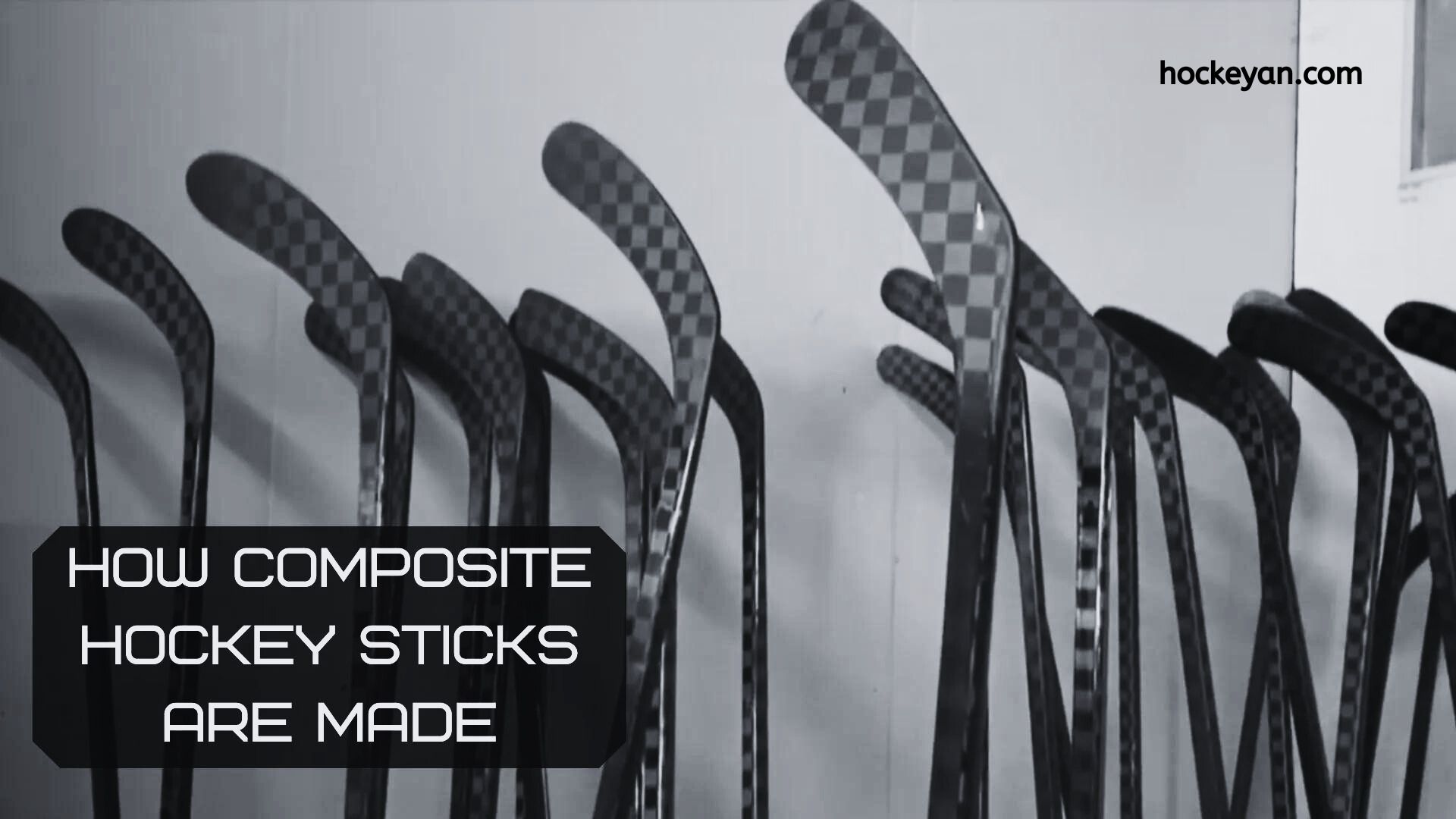What are Hockey Sticks Made Of? Hockey sticks are made of wood, fiberglass, carbon fiber, or a blend of these materials. Modern sticks often use composite materials for better performance.
What are Hockey Sticks Made Of? Hockey sticks have evolved significantly over the years. For decades, wooden sticks were the standard, offering durability and a traditional feel. Today, most players prefer composite sticks made from carbon fiber and fiberglass. These materials provide lighter weight, better flexibility, and increased strength.
Composite sticks enhance shot accuracy and power, making them the choice for professional and amateur players. Selecting the right hockey stick depends on the player’s style, position, and level of play. Understanding the materials used in hockey sticks helps players make informed decisions, improving their game and overall performance.
Credit: gunzos.com
Introduction To Hockey Sticks
Hockey sticks are essential in the game of hockey. They help players shoot, pass, and control the puck. Over time, their design and materials have evolved.
Brief History
Early hockey sticks were made of wood. Mi’kmaq carvers handcrafted the first sticks. They used hornbeam trees, known for their strength. By the 1920s, ash had become the preferred wood. Wooden sticks were heavy and stiff, and they could have been more durable.
Modern Evolution
Modern hockey sticks are made from advanced materials, including fiberglass, carbon fiber, and Kevlar. These materials offer better performance, are lighter and more flexible, and last longer than wooden sticks.
| Material | Advantages |
|---|---|
| Fiberglass | Lightweight, flexible, affordable |
| Carbon Fiber | Very strong, lightweight, excellent performance |
| Kevlar | Highly durable, resistant to wear and tear |
Modern sticks often combine these materials, maximizing performance and durability. Players can choose sticks based on their playing style. For example, some prefer the feel of carbon fiber, while others might like the flexibility of fiberglass.
Traditional Wooden Sticks
Hockey has a rich history, and traditional wooden sticks are a part of it. These sticks are made from natural wood and offer a classic feel and performance. Many players still prefer traditional wooden sticks for their unique characteristics.
Types Of Wood
There are various types of wood used to make hockey sticks. Some common choices include:
- Ash: Known for its flexibility and strength.
- Maple: Offers durability and a solid feel.
- Birch: Lightweight with good balance.
- Willow: Provides a softer touch and feel.
Advantages And Disadvantages
Wooden sticks have their pros and cons. Here is a quick overview:
| Advantages | Disadvantages |
|---|---|
|
|
Traditional wooden sticks remain popular because they are affordable and have a classic feel. They offer a unique experience that many players cherish.
Composite Hockey Sticks
Composite hockey sticks have revolutionized the game of hockey. They are lightweight, durable, and offer better performance. Unlike traditional wooden sticks, composite sticks are made from advanced materials. These materials enhance the player’s control and shot power. Let’s dive into the details of composite hockey sticks.
Materials Used
Composite hockey sticks are made from high-tech materials. The main materials include carbon fiber, fiberglass, and aramid. Carbon fiber is strong and lightweight, providing excellent stiffness and durability. Fiberglass adds flexibility and toughness. Aramid, also known as Kevlar, increases impact resistance. These materials work together to create a superior hockey stick.
Manufacturing Process
The manufacturing process of composite hockey sticks is complex. It starts with layering sheets of carbon fiber. The sheets are cut and placed in a mold. Resin is then applied to bond the layers. The mold is heated and compressed, hardening the stick and giving it its final shape.
After molding, the stick undergoes finishing processes. It is sanded and painted. A grip coating is applied to the handle. The blade is reinforced for added strength. This ensures the stick is ready for high-level play.
The result is a high-performance hockey stick. It is lightweight, durable, and offers excellent control. Players of all levels prefer composite sticks for these reasons.
| material | properties |
|---|---|
| Carbon Fiber | Strong, Lightweight, Durable |
| Fiberglass | Flexible, Tough |
| Aramid (Kevlar) | Impact Resistant |
Credit: olympics.com
Carbon Fiber Sticks
Hockey sticks have evolved greatly over the years. Carbon fiber sticks are now among the most popular choices. These sticks are known for their strength and flexibility. Let’s explore what makes carbon fiber sticks special.
Strength And Flexibility
Carbon fiber sticks offer unmatched strength. They can withstand powerful shots and intense gameplay. The sticks are also very flexible, which allows players to handle the puck better and make quick and accurate shots.
The combination of strength and flexibility makes these sticks ideal. Players at all levels prefer them for their performance. Carbon fiber sticks are also lightweight, making them easy to maneuver during fast-paced games.
Popular Brands
Several brands produce high-quality carbon fibre sticks. Here are some of the most popular ones:
- Bauer: Known for their innovative designs and technology.
- CCM: Offers a variety of models to suit different play styles.
- Warrior: Provides sticks that are both durable and high-performing.
- True: Focuses on precision and control with their sticks.
Each brand has its unique features. Players often choose based on personal preference and style. These brands ensure top-notch quality and performance.
Fiberglass In Sticks
Hockey sticks have evolved over the years. Modern sticks often use advanced materials. One such material is fibreglass. Let’s explore the role of fiberglass in hockey sticks.
Impact On Performance
Fiberglass enhances the performance of hockey sticks. It allows players to shoot harder and pass with precision. The material is lightweight. This helps players move quickly and easily. Fiberglass also adds flexibility. A flexible stick can absorb and release energy efficiently.
Durability
Fiberglass increases the durability of hockey sticks. It makes the sticks resistant to wear and tear. This means they can withstand rough play. Players do not have to worry about frequent replacements. Fiberglass also protects against impacts. This ensures the stick lasts longer.
Overall, fibreglass is a game-changer. It improves both performance and durability. No wonder many players prefer sticks made with fibreglass.
Kevlar Reinforcement
Hockey sticks need to be strong and durable. This is where Kevlar reinforcement comes in. Kevlar is a synthetic fibre known for its high strength. It is used in many high-performance products. Kevlar reinforcement makes hockey sticks tough.
Benefits Of Kevlar
- High Strength: Kevlar is five times stronger than steel.
- Lightweight: Despite its strength, Kevlar is very light.
- Durability: Kevlar resists wear and tear.
- Flexibility: Kevlar can bend without breaking.
Usage In High-end Sticks
High-end hockey sticks often use Kevlar. This adds to the stick’s performance and durability. Players prefer these sticks for their reliability.
| Feature | Benefit |
|---|---|
| Strength | Withstands hard shots and impacts |
| Lightweight | Easy to handle and manoeuvre |
| Durability | Lasts longer than regular sticks |
| Flexibility | Reduces the risk of breakage |
Kevlar in high-end sticks provides a better game experience. Players can shoot harder and faster. The stick remains intact even after tough games.
Comparing Stick Materials
Hockey sticks come in different materials. Each material affects the stick’s performance. Understanding these differences can help players choose the best stick.
Weight And Balance
The weight and balance of a hockey stick are crucial. Wooden sticks are heavier but offer a good balance. Composite sticks are lighter, providing quicker movements. This helps in fast-paced games. Aluminium sticks fall in between, offering a mix of both.
| Material | Weight | Balance |
|---|---|---|
| Wood | Heavy | Good |
| Composite | Light | Excellent |
| Aluminum | Moderate | Good |
Performance Differences
Different materials affect performance in various ways. Wooden sticks offer great control and feel. Composite sticks provide more power and precision. They are also more durable. Aluminium sticks offer a balanced performance, being sturdy and reliable.
- Wooden Sticks: Best for control and feel.
- Composite Sticks: Best for power and precision.
- Aluminum Sticks: Balanced performance.
Credit: www.purehockey.com
Choosing The Right Stick
Choosing the right hockey stick can impact your performance. The right stick helps in control, power, and precision. Different factors affect your choice.
Player Position
Your position in the game influences the type of stick you need.
- Forwards: Lightweight sticks for speed and quick shots.
- Defensemen: Heavier sticks for strong checks and long passes.
- Goalies: Specialized sticks with wider blades for blocking pucks.
Playing Style
Playing style determines the stick’s flexibility and strength.
- Wrist Shot Players: Flexible sticks for quick releases and accuracy.
- Slap Shot Players: Stiffer sticks for powerful and hard shots.
- All-Round Players: Balanced sticks for versatility in all situations.
| Player Type | Ideal Stick Type |
|---|---|
| Forwards | Lightweight |
| Defensemen | Heavier |
| Goalies | Specialized |
Consider both position and style to find the perfect hockey stick.
https://www.youtube.com/watch?v=
Future Of Hockey Stick Materials
The future of hockey stick materials is exciting and full of innovation. New technologies promise better performance and sustainability. Hockey players eagerly await these advancements.
Innovative Materials
New materials are revolutionizing hockey sticks. These materials are lighter and stronger. They improve gameplay and player safety.
| Material | Benefits |
|---|---|
| Graphene | Extremely strong and lightweight |
| Carbon nanotubes | High durability and flexibility |
| Kevlar | Enhanced impact resistance |
These materials offer a range of advantages. Graphene is extremely strong and lightweight. Carbon nanotubes provide high durability and flexibility. Kevlar enhances impact resistance.
Sustainability Considerations
Sustainability is crucial in new material development. Future hockey sticks will focus on eco-friendly materials.
- Recycled carbon fiber
- Bio-based resins
- Natural fibres like flax
Recycled carbon fibre reduces waste and repurposes materials. Bio-based resins are made from plants and are biodegradable. Natural fibres like flax are renewable and eco-friendly.
These sustainable materials help protect the environment. They ensure the sport remains enjoyable for future generations.

Credit: www.denverpost.com
Frequently Asked Questions
What Are NHL Hockey Sticks Made Of?
NHL hockey sticks are made of composite materials like carbon fibre. These materials offer strength, flexibility, and lightweight properties.
Does Anyone In The NHL still Use A Wooden Stick?
Yes, a few NHL players still use wooden sticks. Most prefer composite sticks for their lightness and durability.
Why Are Hockey Sticks Made Of Carbon Fiber?
Hockey sticks are made of carbon fibre for strength, durability, and lightweight performance. This material enhances shot power and control.
Why Do NHL sticks Break So Easily?
NHL sticks break easily due to their lightweight design and high-impact collisions. Composite materials offer performance but reduce durability.
Conclusion
Understanding the materials of hockey sticks can enhance your game. Choose wisely between wood, fibreglass, and composite. Each material offers unique benefits. Discover the perfect stick for your style and skill level. Invest in the right hockey stick to boost your performance on the ice.
Happy playing!







